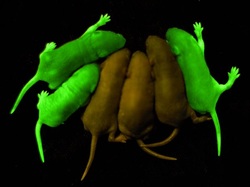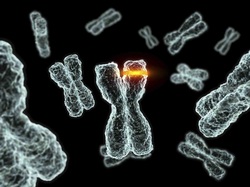Genetic Modifying of Organisms

Genetically Modified Strawberries
One of the more prevalent controversies is in regards to a medical application of gene therapy--genetically modifying foods and organisms (GM). Many fear that GM crops carrying genes from other species, might harm the environment or be hazardous to human health. However, researchers may be able to prevent the escape of plant genes, for example, by engineering plants so that they cannot breed. In addition, the U.S. National Academy of Sciences released a study that found that these plants and organisms posed no threat or risks to health or environment, and as a matter of fact, in the United States, all genetically modified "projects" are evaluated for potential risks by several regulatory agencies, including the Food and Drug Administration, the Environmental Protection Agency, the National Institute of Health, and the Department of Agriculture.
Genetic Diseases and Eliminations

Glow-in-the-dark gene from jellyfish
inserted into mice.
Human gene therapy, is predicted based on results in lab animals. It is those experiments that determine, partly, why certain genetic diseases are not good candidates for gene therapy and which diseases may be approached by gene therapy. However, although genetic engineering of gametes (germ line therapy) has been accomplished in lab animals it has not been attempted in humans because such procedures would raise very difficult ethical questions about altering evolution. In addition, there will always be patients who suffer from genetic diseases, because new mutations will always occur, making it impossible to eliminate genetic defects.
Candidates of Gene Therapy

A mutated fragment of a chromosome
There are several genetic diseases that make poor candidates for treatment by gene therapy which include:
The button below will lead you to a site that shows several of the many deficiencies that can be cured by the use of gene therapy.
- Chromosomal disorders, such as Down Syndrome, which are scientifically impossible to be treated by gene therapy because these disorders affect fragments of a chromosome which typically contain hundreds or thousands of genes. This is why it is virtually impossible to insert enough DNA to correct such large defects because the disability is not focused on one specific gene, or group of genes.
- In addition, complex traits, such as intelligence and physical stamina and dominant traits, or poorly understood recessive traits, are not sufficiently well understood and are not justified to be considered as "therapy" of genes.
The button below will lead you to a site that shows several of the many deficiencies that can be cured by the use of gene therapy.
Criteria for Undertaking Gene Therapy
The factors that are taken into consideration of which application of human gene therapy might be approved include efficacy, safety, reliability, alternatives, and severity of symptoms; nonetheless, each criterion varies between each individual patient.
Many of the ethical and religious concerns expressed about human gene therapy refer to the procedures that might affect the germ line and result in inherited changes. However, treatment of somatic cells does no pose ethical problems different from those represented by other new types of experimental therapy. Some of these similar concerns include:
Many of the ethical and religious concerns expressed about human gene therapy refer to the procedures that might affect the germ line and result in inherited changes. However, treatment of somatic cells does no pose ethical problems different from those represented by other new types of experimental therapy. Some of these similar concerns include:
- Side effects;
- Alternative treatments, if any;
- Seriousness of the disease to qualify for the procedure;
- Medical precautions to misapplications;
- Informed public on treatment
